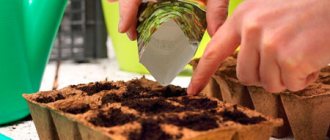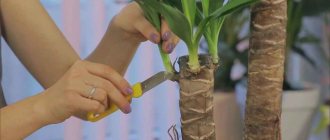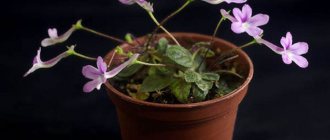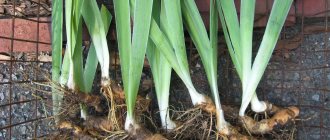Violets have been popular among gardeners for many years. They are grown not only as a houseplant, but also to create alpine slides and rockeries in the summer. The plant invariably arouses great interest among breeders due to its variety of shapes and colors, so the number of Saintpaulia varieties increases every year. To successfully grow a flower, it needs to create suitable conditions. Then it will delight you with its lush flowering for a long time.
For propagation by seeds, breeders use different varieties. This method can be used to grow indoor Usambara violets and all varieties of garden viola. Among the variety of Saintpaulia varieties, they are distinguished by the following characteristics:
- Based on the diameter of the rosette, violets are divided into micromini, mini, midi, standard and large.
- The inflorescences have a classic shape, bell-shaped, in the form of a star, wasp or spider. Flower petals are simple, semi-double or double. The color of flowers can be monochromatic, two-tone or multi-colored.
- Leaves are divided according to shape and color. The edges of the leaflets can be either solid or jagged or wavy.
For growing in an apartment, the following varieties are most often used:
- Caprice - with white double flowers with a greenish fringe and wavy leaves of variegated colors.
- Macho - has purple double flowers with a white border and simple green leaves.
- Your Majesty - distinguished by pink double flowers with wavy edges and bright green leaves.
- Sea Wolf - has large blue flowers with a mesh pattern, the foliage of this variety is dark in color.
- Jabot - with dark blue flowers with a greenish wavy border and wavy leaves.
To grow violets from seeds at home, you must first take care of suitable soil for it. The soil can be purchased at a specialty store or made independently. Soil containing a lot of clay is not suitable for violets. In such soil, the plant is very likely to get sick or even die. If you decide to use ready-made soil, then it is preferable to use one that contains disintegrants. Typically, this is performed by perlite or vermiculite, which retain moisture well and provide air access to the root system. Since violets feel better in acidic soil, peat must be present in it. When preparing the soil yourself, it is mixed from equal parts of perlite and crushed peat.
It is convenient to use phyto-cassettes with lids for sowing seeds. A drainage layer of broken shards is poured onto their bottom. Then you need to pour a layer of coarse river sand and lay a layer of sphagnum moss. Lastly, the soil is poured. Before filling containers, all materials must be sterilized. The shards and sand are kept for some time in a hot oven, and heating with water steam is used to sterilize the soil and moss.
Uzambara violet has very small seeds, so it is recommended to pan them before planting. This will allow for more economical and uniform use of planting material. The procedure is carried out in two stages:
- 1. The seeds are sprayed with water and the same amount of crushed charcoal is added. The mixture is placed in a jar and shaken for a while, after closing the lid. As a result, coal dust envelops the seeds and disinfects them.
- 2. Add the same amount of sand and shake vigorously again.
The prepared seeds are scattered in a thin layer on moist soil and covered with a lid. Containers with seeds are placed in a warm place so that direct sunlight does not fall on them. Now you need to control temperature conditions and constantly moisten the soil until the first shoots appear.
At the stage of seed germination, the temperature should not fall below +20 degrees. Then the first shoots will appear on the 20th day after sowing. If you increase the temperature to +25 degrees, the violets will germinate in two weeks.
After the first shoots appear, the lid is removed. Watering the seedlings should be done by spraying the soil with a spray bottle. When the first leaves appear and the seedlings grow to 0.5 cm, they need to be picked. The plants are dug up using a toothpick and transplanted into fertile soil with the addition of charcoal. Keep a distance of 2 cm between plants.
When the little violets grow up and feel crowded, make a second pick. They are placed one at a time in disposable cups. When the root system gets stronger, Saintpaulias are transplanted into pots. The containers for this purpose are small and shallow. The diameter of the pot should be three times smaller than the diameter of the rosette, then Saintpaulia will bloom well. From this moment on, violets need to be provided with warmth and constant soil moisture.
It must be remembered that direct sunlight is detrimental to violets; they cannot tolerate low temperatures or drafts. In general, homemade Saintpaulias do not require careful care, only some varieties have special requirements.
What do indoor violet seeds look like?
First of all, it is worth buying high-quality seed material. Many beginners, and sometimes even advanced gardeners, do not pay proper attention to this stage and ultimately remain dissatisfied with the result. First you need to purchase a seed pod, but not at the market, but in a specialized store or at a flower exhibition.
The Saintpaulia pestle should be cleaned. Then use a needle to open the box. Ideally, there should be a lot of seeds, but sometimes unscrupulous suppliers do not provide the plant with proper care, as a result of which movra is born in small quantities. Very often sellers use different tricks, so you should be careful when choosing and purchasing, especially on the Internet.
A normal moura will look like this:
- tiny, resembles grains of sand, but don’t worry, because this is the norm;
- has a limited range of colors, from black to brown;
- oblong, looks like small coffee granules with pointed ends.
Variety of violets
The home violet is a relative of the garden violet. Therefore, their “claims” are practically the same. But you should still make an estimate on the growing conditions, because artificially created ones cannot completely reproduce the natural habitat for these flowers.
Therefore, in apartments you can see mostly hybrid varieties of violets, which are grown to adapt to the home climate. The diversity of species includes varieties that differ not only in size and colors (plain or vibrant with a wide range of colors), but also in different shapes of petals and inflorescences.
Along with traditionally developing bushes, hanging varieties are also found among domestic violets. But on the branched stems, smoothly “flowing” down, there are much fewer inflorescences.
10 shade-loving indoor plants that will decorate your home
Sowing seeds
The grains of violets are very small, so before sowing, panning should be carried out to provide a protective film for the seeds. Due to this procedure, they are covered with a ballast layer, as a result of which they increase in size and become more convenient to use.
The soil
Soil is an important element in growing Saintpaulia. Many stores have a special substrate intended for this type of flower, but it is important to consider the following: often such soil does not absorb water, the liquid simply flows down the walls of the pot. There is only one way out - to prepare the soil for sowing with your own hands. To do this you need:
- Carefully sift the garden soil.
- Add some sand. With the presence of this component, the violet root system will develop perfectly and painlessly.
- Heat the soil in the oven. At this stage, all pests that could interfere with the normal functioning of Saintpaulia are destroyed.
- Place a layer of expanded clay at the bottom of the container.
Pots
It is better to purchase special phyto-cassettes with a lid, but a regular pot will also work well. It is important that it be small, since the root system of these lovely flowers is small, so excessive size will not allow the plant to develop normally.
Landing
Growing Saintpaulia is a rather labor-intensive, but generally uncomplicated procedure. In this matter, it is important to listen to the advice of experts on how to grow violets from seeds at home, as well as to carry them out step by step and in a concentrated manner. Seeding is carried out as follows:
- First, the top layer of soil is sifted using a sieve and the prepared vessels are filled.
- Immediately before sowing, it is necessary to water the soil with a fungicidal avicide.
- Wait until the soil dries. Then make grooves into which the grains will be sown.
- We sow our furrows with grains and pour a thin layer of soil on top.
- Immediately after planting, you need to water the soil.
Planting violet seeds
Growing violets from seeds at home is not difficult. The main thing is to listen to the advice of experts and carry out all the steps step by step. Planting Saintpaulia seeds is carried out in the following order:
- first, sift the top layer of soil mixture through a sieve and fill the containers prepared in advance with soil;
- the ground should be watered with a fungicidal agent immediately before planting;
- let the substrate dry a little. Only after this make small grooves in the ground, where you will need to sow the Saintpaulia seeds;
- Next, we plant the grain material and cover the seeds with a small layer of soil on top. Take a regular sieve; with its help this will be much easier and more convenient;
- After planting, be sure to water the soil.
Even a beginner can grow violets from seed. No special skills are needed here; the main thing is to know what this process consists of, at least theoretically.
Reproduction
Having grown a violet from seeds, every amateur gardener experiences pleasure and genuine joy. After all, in this way you can get completely different types and colors: from ordinary to elite terry. This is because plants have unstable DNA, as a result of which almost 100% of new flowers differ from the mother flowers. It’s safe to say that propagating violets by seeds is an interesting and rewarding endeavor.
Is it possible to breed a new variety of violet at home?
First of all, you need to be persistent, because breeding a new variety is a labor-intensive and time-consuming procedure. Sometimes more than ten pollination attempts are made before the desired shoot is established. For example, it took at least five years to develop the “Vernost” variety.
How to breed a new variety of violet at home
The process of violet selection at home is a painstaking task. When pollinating a flower, follow a certain algorithm:
- Carefully open the anthers of the plant with a needle.
- Apply the resulting pollen to the pistil of the flower, thus pollinating the violet. The pollen will ripen 5 days after opening, and its capacity for gynogenesis is not lost for 3 months.
- After the formation of the pistil, the flower with the fruit will turn into a box (in which the tiny seeds are born). If drops of a viscous, sticky solution appear on the stigma, the pestle is ripe.
- After 5, and sometimes 6-7 months, the stem dries out and the seeds ripen. At this time, you need to remove the boxes, dry them a little and open them.
- Pour the grains into a paper bag and place in a warm, dry place. They should be removed 2-3 weeks after ripening.
How new varieties of violets are developed
It is extremely difficult to convey the qualities inherent in parents to violet children. The fact is that they have a dominant dark color (when crossing purple and white, blue and pink, we get a predominance of purple and blue) and ordinary varieties (when crossing double with simple, we get all simple with a few semi-double). Flowers that have been grown from seed do not have the opportunity to reproduce all the characteristics of the variety. New selection of violets at home is possible, but requires repeated crossings of various species. This will take years of hard work. You need to be patient.
Selecting seeds for planting
They buy planting material in special stores or from experienced flower growers and collectors. The best option is to purchase a seed box indicating the names of the parent varieties.
Ripe seeds appear black and shiny. To get a good look at them, use a magnifying glass. Round-shaped fruits can contain up to 100 seeds, the largest ones can contain up to 200, and the subulate ones have the fewest.
Under natural conditions (in the mountains of Tanzania and Kenya), violets reproduce mainly by cross-pollination. They keep the pistil much higher than the stamens to prevent self-pollination, which, like propagation by cuttings, gradually leads to the extinction of the variety.
To breed violets at home, seeds are obtained by pollinating the plants themselves. The best time for this is a sunny morning. Pollen from a flower that blooms for 5 days is transferred to the pistil of the mother plant. This is done with a needle, cotton swab or soft brush.
How and when are violet seeds collected?
After successful pollination, the ovary begins to grow and a seed capsule (fruit) is formed. If pollination was carried out in the spring, its maturation can last 5-6 months, if in the fall - 7-9.
The fruit can be ovoid, spindle-shaped or awl-shaped. Its valves may collapse from excessive moisture or open when fully ripe, then the seeds will spill into the pot.
It is difficult to catch the moment of full ripening, therefore, in order not to take risks, you should remove the dried peduncle from the socket a little before the plant spontaneously gets rid of the seeds, focusing on the formal signs - drying of the peduncle and a change in the color of the fruit to brown.
If you remove the seed pod from a mother violet too early, it may not contain any viable seeds. If this is done 3-4 weeks before its natural opening, the seeds will have a germination rate of up to 80%.
Having separated the box, it is dried for 1-3 weeks in a warm, dry place. They open it by running the point of a needle along it, and pour the seeds onto white paper - this way they are better visible and easier to pour.
Proper storage
It is best to store seeds in a seed box, placing it in a paper bag or bottle. If it is opened, the seeds can be planted immediately or within 2 years. Store them in a linen or paper bag or matchbox. Storage conditions:
The bottom shelf of the refrigerator or the cellar meets these requirements.
You can store seeds at a temperature of +15...+20°, but not more than 1 year.
Violet propagation
As the violet grows, it is transplanted into larger containers. The best period for this is spring (March or April). At the same time, flowers are propagated. Saintpaulia can be propagated in several ways.
- Stepsonning.
In an adult plant, carefully cut off with a scalpel the stepsons on which at least 3 leaves have formed. The stepson can be planted directly in the soil, the composition of which was described above. Either first in a peat tablet, and when the stepson takes root, transplant it into the ground. - Subsidiary sockets.
The violet develops in inflorescences. And the more of them there are in one pot, the more difficult it is for the plant to develop. When daughter rosettes form, they should be cut off from the mother plant and planted in separate pots. - Cuttings.
Vegetative propagation of violets is the most popular, and the cutting method is the simplest. But only the leaves located in the second row of the plant should be cut off. You can propagate by cuttings in 2 ways: by planting directly in an earthen substrate or by first rooting the leaf in an activated carbon solution.
Features of reproduction
Whatever propagation method is chosen, cutting off parts of the plant is carried out with extreme caution.
The cut areas must be sprinkled with activated carbon powder (crush the tablet). This will prevent the violet from being damaged by microbes.
To ensure faster rooting of planting material, it is necessary to create greenhouse conditions. Cover the container with a plastic bag or piece of glass and leave it like this for several days. But do not forget to ventilate daily so that the young shoots do not rot.
Appearance and general description
Saintpaulia grows quickly and blooms all year round. Modern indoor violets are hybrids in which breeders can specify the frequency of flowering, the number of peduncles and buds, and shades of the flower. The number of varieties amounts to thousands and increases every year.
Externally, the plants differ as follows:
- according to the size of the outlet - from small (8 cm in diameter) to standard (20-40 cm);
- by type of flower - simple, scalloped, double, semi-double, with corrugated or wavy petals;
- according to the shape of the flower - pansy, star, cup, bell, wasp;
- by flower size – small (2 cm), large (4-6 cm) and especially large (more than 6 cm);
- in color - plain (from white, blue and pink to red-violet), variegated (with spots, strokes, stripes, dots, veins or a mesh pattern).
5-7 Saintpaulia flowers are collected in a loose cluster, the leaves are fleshy, dark, pubescent above, green or grayish below. Variegated varieties have elegant, brightly colored foliage with many shades and contrasting spots.
The ampelous ones are characterized by a stem up to 50 cm long with several growth points, small flowers and variegated leaves.
Despite the fact that violets are indoor plants, landscape designers suggest using them to create compositions in a landscape style.
Flower pots are taken out onto balconies, into garden gazebos, planted in large boxes, in flower beds. In the fall they take it into the house. Saintpaulias are afraid of temperature changes and drafts.
How to plant a violet leaf without roots?
Selection of capacity
A good container for rootless propagation directly into the ground can be small cups or pots, up to 200 ml in volume and about 5 cm in diameter.
Experienced violet growers advise using disposable plastic cups for these purposes.
Their transparency allows you to monitor the condition of the soil, and the material is easy to make drainage outlets.
Priming
An important component when planting a leaf with a cutting is the selection and arrangement of the soil mixture. If ready-made soil is purchased, it should be intended for flowering ornamental plants
Leavening agents made from inert materials or sphagnum moss must be added to it.
Experienced violet growers prefer to prepare the mixture themselves. To do this, they mix perlite and vermiculite in equal proportions, without adding them to the soil composition. Perlite provides breathability to the roots, and vermiculite provides moisture absorption and looseness
Inexperienced flower growers are better off purchasing ready-made soil and adding perlite and sphagnum moss, which has antibacterial properties.
Inexperienced flower growers are better off purchasing ready-made soil.
Some gardeners recommend growing on pure perlite, but with this composition you should strictly monitor the humidity level. A fragile plant without a sufficient amount of moisture, and perlite is not a moisture-intensive component, dries out quite quickly, which can result in death for such a weak future plant.
Selection and preparation of planting material
The correctly selected material is important and decisive for the further development of Saintpaulia, so this step must be taken responsibly. If you thoroughly examine the structure of the violet, you will notice that the leaves are arranged in rows on the rosette
First of all, you need to decide which row is preferable to take the material from:
- 1st, bottom row - the leaves are relatively old and, due to their age, may not bear children for a long time. In addition, their close location to the ground often provokes the picking up of various diseases and pests;
- 2nd-3rd rows - with young, already strong leaves. The most optimal option for planting material;
- the middle of the rosette - the leaf is usually small, and if torn off there is a risk of damage to the growth point of the Saintpaulia, which can lead to unpredictable consequences;
- the upper rows are young leaves that have not yet become stronger and have not gained enough energy.
The second stage is the selection of the leaf itself for propagation:
- the sheet must be free of any kind of defects (stains, scratches, breaks, etc.);
- must be healthy, with the color characteristic of the variety;
- the structure of the sheet plate should hold its shape well and be elastic.
Important! The leaf is taken only from a healthy plant!
Often, planting material has to be taken from friends or somewhere else, which causes it to wither during long delivery. In this case, it should be immersed for 1.5-2 hours in clean, warm water, slightly tinted with potassium permanganate, and then dried.
The final step before planting is leaf preparation.
Separating a leaf blade from a plant can be done in two ways:
- a simple break;
- using sharp cutting tools.
Experienced flower growers recommend using a sharp knife or pruning shears, performing the operation in a more civilized and safe way.
The cut should be made with a very sharp tool.
The correct cut is considered to be a cut at an angle of about 45° (the area of root formation and nutrition increases). Do not forget about disinfecting the cutting tool and treating the cut site on the mother plant with crushed activated carbon. The length of the stump should be at least 5 mm and no more than 4 cm. Longer cuttings should be shortened.
Propagation by seeds
Reproduction of violets by seeds occurs with splitting of characteristics, and seedlings do not inherit the characteristics of their parents.
Breeders discard up to 95% of the resulting plants, leaving for further work specimens with a beautiful rosette, strong peduncles, interesting color and flower shape. If these characteristics are tested in three generations during vegetative propagation, the plant is considered varietal.
The advantages of growing violets from seeds at home are as follows:
- obtaining a large number of plants of the same age with different colors and shapes of flowers and leaves;
- seedlings are stronger and more resistant to various diseases than those obtained by cuttings.
Disadvantage: flowering will occur later than when propagated by cuttings.
Main varieties
Violets are distinguished by the following characteristics:
- 1 Sizes of sockets: micromini (up to 6 cm), mini M (10-15 cm), midi (15-20 cm), standard (20-40 cm) and large (from 40-60 cm in diameter). Some varieties are hanging or trailer indoor flowers.
- 2 Inflorescences. The types are classic, star-shaped, bell-shaped, wasp-shaped or spider-shaped. Petals can be semi-double, double or single. In hybrid varieties, they can be pointed, rounded, corrugated, smooth or torn at the edges. Based on color, they are divided into single-tone, two-tone and multi-tone.
- 3Leaves, more precisely their type and color. They can be oval, round, kidney-shaped and elongated. The edges of the foliage are entire, corrugated, serrated or wavy. They are usually olive, dark brown, green or greyish.
- Clairvoyant Baba Nina named the zodiac signs for which money will fall from the sky in May 2018...
►
The following varieties can be grown at home:
- 1Caprice. The inflorescences are white, double. The fringe on them is greenish. The foliage is very variegated. They have a wavy structure.
- 2Macho. The flower is purple, but the edges are white. Terry petals. The leaves are simple in shape and green in color.
- 3Your Majesty. This is a pink Saintpaulia with double petals that have wavy edges. The foliage is bright green.
- 4Sea Wolf. A very large blue flower with a net pattern on its petals. The leaves are dark.
- 5Water. The inflorescence itself is blue, but turns into pink and then bronze-green. Light colored leaves.
- 6Jabot. Dark blue inflorescence. Along the edges there are light green ruffles. The leaves are also wavy.
- 7Tomahawk. This violet is a bright red hue. Blooms profusely. The leaves are dark green.
- 8Max Black Pearl. A black violet with a purple tint. Velvet petals. The foliage is small. The plant is very compact.
- 9Parisian secrets. The inflorescence has a dark black-purple hue and a purple-red pattern. There are whitish ruffles. The foliage is variegated.
There are other names for both the domestic violet itself and individual varieties. Now varieties such as Frozen, Green Lace, Irish Cream and others are appearing, which are distinguished by their greenery. New varieties have also appeared with pure yellow petals or with a pattern of this color on them - these are Lemon Kissis, Sunkist Rose and Worm Sunrise.
Time and methods of planting seeds
The most suitable time for sowing Saintpaulia seeds is spring and early summer. In winter, if the air temperature is insufficient and the humidity is high, the seeds may rot. They are planted in the following ways:
- Pour the seeds onto a white sheet of paper and, shaking it, scatter it evenly over the surface of the prepared soil.
- Planted in peat tablets, which are previously kept in warm water until swelling. Place 2 seeds on each tablet and place them in plastic cups or boxes.
- Mix the seeds with sand (1:1) and pour into the grooves.
The seeds of the Uzambara violet are so small that they are compared to dust. If you carry out pelleting, they will be convenient to pick up and evenly distributed over the soil surface, and their quantity required for sowing will be reduced by 1.5-3 times.
Seeds are coated on their own as follows:
- Moisten and mix with an equal amount of crushed and sifted charcoal, place in a glass bottle and shake. Coal dust should cover each seed.
- Add fine sand (the same amount as coal dust).
Dried seeds have a shorter shelf life.
Video: how to grow a violet from a leaf
- Rooting cuttings in the ground. This method boils down to the following steps: the cut cutting is placed in a plastic cup with soil. Holes are first made in the glass, 1 cm of substrate is poured into the bottom, as well as vermiculite and perlite, everything is moistened.
- Rooting flower stalks. This method will require cutting off the top of the mother plant. After this, stepsons begin to grow on the sides, and as soon as they become larger, they are rooted into the ground.
- Propagation by seeds.
Sowing and caring for seedlings
You can buy a special slightly acidic substrate for growing Uzambara violets at a flower shop or prepare it yourself:
- sift the peat through a metal sieve with mesh size up to 1 mm;
- mix peat with fine agroperlite in a 1:1 ratio.
Before planting the seeds, the soil must be steamed to avoid the appearance of fungus. Then it is poured into prepared microgreenhouses - transparent plastic containers 3-5 cm high with tight-fitting lids. It is better to take not just one wide container, but several small ones - in case of infection, some of the crops will be preserved.
The soil in the box is evenly moistened with a spray bottle so that it is not saturated with water to the ground, or the required number of peat tablets is prepared and the seeds are planted using any of the above methods.
After this, the container is closed with a transparent lid, film or glass and placed in a warm place (+23...+25°C) under fluorescent lamps.
Further care is as follows:
- Once a day, open the container for 1 minute for ventilation;
- do not allow the temperature to drop below +20°C;
- moisten the soil with a spray bottle if it is dry.
Excessive moisture harms crops and can destroy them by getting on the leaves and root collar. Therefore, if drops of water fall from the lid into the container, it is worth replacing it with a non-woven covering material to improve air exchange.
The first shoots appear after 15-20 days. They are dived 2 times:
- When 2-4 true leaves appear. Before doing this, you need to moisten the soil so that water does not get on them. If there are drainage holes, the containers are placed in water, and the soil is saturated with water from the bottom up. To avoid damaging the roots of the violets, dig up the plants with a small fork or a toothpick. The seedlings are transplanted at a distance of 2 cm from each other into the prepared substrate, adding a little charcoal to it.
- When the leaves of neighboring seedlings close together, they are transplanted into small plastic cups (100 ml). Plants can be supported by the leaves, but not by the base.
Seedlings grown in peat tablets are replanted along with the tablet. When the young plant has mastered the new container, it can be planted in a pot. Conditions for the normal development of Saintpaulia:
- temperature +16…+25°;
- illumination with fluorescent lamps for at least 12-15 hours a day, the distance from the tops of the seedlings to the lamp is 7-10 cm;
- if the central leaves have lightened, the plant must be fed with fertilizer with a high nitrogen content.
Plant care and nutrition
Caring for violets involves balanced watering, sufficient access to sunlight, and timely feeding.
- Proper watering. When watering, do not allow water to get on the leaves and flowers, and watering should not erode the soil. The permissible water temperature is 18-20 degrees above zero (room), if the water is from the tap, let it stand for up to one hour.
- Sufficient lighting. For violets, the optimal daylight hours are 12-14 hours. When there is a lack of light, the plant becomes elongated and the leaves lose their velvety texture. With too much light, violet growth slows down, the flowers become small and pale.
- Feeding. If the plant is kept under artificial lighting conditions, it needs feeding all year round. The plant is fed with mineral fertilizers and organic matter. Excessive feeding leads to rapid growth of leaves and fading of flowers.
- Additional care comes down to removing dust from the leaves and periodically turning the pots, eliminating pests.
The violet is a wonderful indoor plant; its amazing flowers can create a decorative effect and bring special comfort to your apartment. It is not difficult to propagate this flower, if you decide to do it using seeds, take the choice of seed material seriously and then you will achieve the desired result.
The nuances of growing violets from seeds
To grow violets from seeds, you need to consider the following:
- Saintpaulia germinates better in the light, so the seeds are not sprinkled with soil when sowing;
- the soil in the pot should always be slightly moist, but if it dries out, it should not be filled with water - this is detrimental to both seedlings and adult plants;
- Saintpaulias love sunlight, but not direct, but diffused;
- water the seedlings with water at room temperature (or slightly higher), standing for 2-3 days in an open container to ventilate the chlorine;
- when watering, use a watering can with a narrow long spout or a syringe; the water should not erode the soil;
- You cannot feed plants earlier than 3-4 weeks after picking or transplanting.
The roots of violets are located close to the surface, weakly developing deeper. Therefore, in a large pot, the soil, not covered by roots, turns sour, dense foliage may form, but flowering will be poor or not at all.
Young plants are planted in pots measuring 5x5 cm; for an adult, it is selected so that it is 3 times smaller than the diameter of the crown.
The seeds have sprouted - what to do?
After the emergence of fragile shoots, it is especially important to provide sufficient lighting for babies. The light should not be bright, diffused. The air temperature must be lowered to 16-18°C - this indicator is optimal for the normal development of seedlings. Higher temperatures will cause the plants to become stretched out and they will be weak and non-viable. In no case should there be drafts in the place where the container with seedlings is located.
You should be especially careful when watering seedlings. Soil moisture should be regular and moderate. Drying out the soil is detrimental to seedlings, just like flooding it. Small violets should be watered with warm, settled water. You can use rainwater.
If the above conditions are not met, the seedlings may die. In addition, you need to monitor the absence of pests; they may well attack delicate plants. If you identify the first signs of their appearance, you need to immediately treat them with insecticides.
Growing violets for seeds
The main condition under which Saintpaulia can reproduce is that the mother plant must be healthy. It must be inspected for the presence of pests (aphids, mealybugs) and diseases (powdery mildew, gray rot, rust). You need to choose a violet for pollination, focusing not only on beautiful flowers, but also on important inherited traits:
- strong socket;
- a large number of flowers;
- clearly defined symmetry of the bush;
- blue, white and purple colors dominate.
Young Saintpaulias pollinate and bear fruit better, so it is advisable to select plants of the same age. If the selected parents bloom at different times, their flowering dates can be changed by the following methods:
- to speed things up - raise the temperature to +21°C, place the plant under red fluorescent lamps, and feed it with phosphorus fertilizers;
- for detention - placed in a cool room, placed under a fluorescent lamp of daylight or blue color.
In order for the plant to be healthy and strong, for its growth it is necessary to maintain a comfortable temperature, regularly water it and fertilize it for flowering once every 2 weeks with phosphorus-potassium fertilizers.
If there is not enough light in winter, there is no possibility of illumination, it is better not to fertilize the violet, but to give it a rest.
And a little about secrets...
The story of one of our readers, Irina Volodina:
I was especially distressed by my eyes, which were surrounded by large wrinkles, plus dark circles and puffiness. How to completely remove wrinkles and bags under the eyes? How to deal with swelling and redness? But nothing ages or rejuvenates a person more than his eyes.
But how to rejuvenate them? Plastic surgery? I found out - no less than 5 thousand dollars. Hardware procedures - photorejuvenation, gas-liquid peeling, radio lifting, laser facelift? A little more affordable - the course costs 1.5-2 thousand dollars. And when will you find time for all this? And it's still expensive. Especially now. Therefore, I chose a different method for myself...
Read the article >>
Amazingly beautiful delicate inflorescences of violets are a real decoration of alpine hills, flower beds, balconies and loggias. But there is a variety of these plants that are grown at home. And their scientific name is “Saintpaulia”.
Despite the fact that indoor violets are unpretentious plants, for some reason they do not take root with some novice gardeners. There may be several reasons for this and all of them, as a rule, are associated with violations of the requirements for caring for Saintpaulia.
Popular varieties of horned violet
- viola tricolor (Pansy) - a tricolor flower, height no more than 20 cm, can grow in the wild, blooms all season;
- Viola Vitroka is a garden plant, height 40 cm or more, the colors of the flowers are very diverse - even black;
- Horned viola - flowers are lilac or violet; when flowering, it forms a thick carpet, blooms from early spring until the first frost;
- Viola Altai - blooms very beautifully twice a season;
- Viola fragrant - beekeepers love it very much, as it has an unusual aroma that attracts bees. Used in perfumery for the production of essential oils;
- Viola Sororia is one of the first to bloom; already in May you can admire its flowering;
- yellow viola is a very unpretentious plant, grows under any conditions, blooms with bright yellow flowers. Even a novice gardener can grow it.
Growing from leaves
Saintpaulia is usually propagated by leaves . Cut them from the plant you like. This is the easiest and most effective way. The most favorable and correct period for violet propagation by leaves is the spring and summer seasons, when it can be grown fully and without much effort.
The choice of leaf is very important, the success of the entire event largely depends on it:
- The leaf should not be sick or weak, since the plant will also not be viable in the future.
- A leaf that is too small will not work.
- A leaf from the lower tier, located right next to the ground, is not desirable; pathogenic microorganisms often nest there, and the leaves themselves are mostly old and lethargic.
- An elastic leaf of normal color and size is ideal; cuttings from the third and second tiers are most suitable.
- It is important to water the plant regularly before taking a cutting.
A long journey and poor watering of the mother plant have a bad effect on the planting leaf . To compensate for these problematic aspects, shortly before planting, you can put the leaf in warm water for a while, with a small addition of potassium permanganate, until it turns slightly pink. When the cutting recovers, it needs to be trimmed, leaving 3-4 centimeters from the base.
There are two main methods for rooting violet leaves - rooting in water and soil.
How to root in water?
The advantages of the method are that it is possible to observe the roots, promptly preventing putrefactive phenomena and accurately determining the time of planting in a permanent place:
You will need a small glass cup or a dark-colored medical vial; this will reduce water contamination by algal fragments.- It needs to be washed and sterilized with boiling water.
- Fill with settled or boiled water.
- The sheet needs to be deepened into the bubble by one and a half to two centimeters. The cut should not touch the walls or the bottom, so it is fixed with a lid with a hole made in the center.
- For microalgae, you can put activated carbon in the water, one tablet.
- You should monitor the water level, as it will be absorbed by the leaf and evaporate, adding liquid in a timely manner.
Roots form in a couple of weeks, or even in a month, it depends on the variety of Saintpaulia. When rot appears, the leaf is removed, dried and damaged areas are removed . The sections are powdered with activated carbon powder.
Watch a video about rooting violet leaves in water:
When is the time to plant in the soil and how to do it?
It is grown in plastic glasses or in small pots with holes to drain excess water:
- A third of the pot or glass is covered with fine drainage.
- Then the prepared, loosened and moistened soil is poured to the very top.
- The cuttings are inserted shallowly into the top layer of soil.
- The earth is carefully compacted around the stem so that it does not tilt to one side and fall.
- Make a mini-greenhouse by loosely covering a container with a violet leaf with a plastic bag. It is necessary to ventilate it periodically to prevent the soil from becoming moldy.
- A greenhouse is needed until the children appear. This is a sure indicator that the process of growing from a leaf has become a reality.
- The children are seated in different pots.
The remaining nuances of care, soil mixture, etc. do not differ from those described above in the section on the seed propagation method.
Details about the separation of children
Rosette daughters appear near the base of the cuttings . They are divided based on the following principles:
- at least a couple of leaves for each plant;
- a small root for each individual;
- To make the division less traumatic, you need to moisten the soil and remove the cuttings from the ground.
How to root in the ground?
IMPORTANT : It is believed that this way the plant takes root faster, there is much less risk of rotting, and more children appear.
You will need a special primer with raising agents; it is sold as a special mixture. You can simply mix vermiculite and perlite in equal parts without adding nutrient soil. Perlite helps air penetrate to the roots, and vermiculite absorbs moisture .
Carefully break off the stalk, moving it away from the plant.- Cut the stem obliquely or at right angles.
- Then dip for three seconds in a slightly pink solution of magrants.
- Leave to dry for half an hour.
- Next, fill the plastic cup with the slightly moistened mixture.
- Insert the stem of the leaf into the soil and compact it so that it does not fall to one side.
- They make a mini-greenhouse using the method described above.
- Do not water on the day of planting.
- At first the leaf will wither, this is normal. When the first roots appear, the leaf turgor will be restored. Watering is done once every seven days, very moderate.
- Do not fertilize, as this factor will force the leaf to grow roots more quickly in search of food.
Watch a video about rooting violet leaves in the ground:
White violet description and characteristics
The white violet is a herbaceous house flower; it has no central stem, is low-growing and perennial. The leaves are dense in structure; during the growing season they form into a rosette located at the roots. The main characteristic feature of the leaves is that they are elongated and sharp, and they can be colored either dark or light green. In some varieties, the leaves are covered with a pattern in the form of spots; this crop is called Saintpaulia.
Household violet plants have differences in shape and flowering period; they can be painted in snow-white colors of one tone or have patterns with a border or interspersed. If you care for the flower properly, it will bloom for a long time, often for ten months. When the plant has flowered, a fruit-box will form on it, which is filled with small grains. Seed germination lasts two years. Typically, the flowering of such violets begins in the spring season, at this moment the first single buds bloom in the form of an oval, containing 5 petals each.
White violet, as a rule, reaches a height of fifteen to forty cm, growth depends on the characteristics of the variety. The root system of the white violet is structured in a special way - the roots are woody and thickened. The stems are slightly shortened and slow-growing; therefore, the leaves are pressed tightly against each other and form a compact rosette. The root system includes both the leaves and peduncles of the flower.
Flowers, leaves and stems have healing qualities, they have an antiseptic effect, help with kidney and colds, and cope with problems of the gastrointestinal tract. This is explained by the fact that during the development of a plant, a large amount of useful elements accumulates: vitamin C, rutin, salicylic acid, carotene. In addition, the green mass contains glycosides necessary for the human body. Before using the culture as a remedy, consult a specialist, as there are contraindications.
Nowadays, white indoor violet is grown by a large number of gardeners because it is easy to cultivate. In addition, there are varieties of such flowers that grow in parks, forests and gardens. For the successful development of this plant, you need to know the main characteristic features that relate to this variety, and when cultivating, act as indicated below.
Create the right type of outlet. The violet will look gorgeous if it turns clockwise to the sunny side from time to time.
Form into a compact size. As the bush matures, it is pruned; for this purpose, the lower leaves are removed. As a result, you will receive a decorative miniature bouquet, which is decorated with several rows of green foliage.
Rejuvenate and propagate an old plant. If the stem becomes too long, it is cut off. This way you will get brand new young leaves. To rejuvenate a flower, you can replant it; to do this, use part of the root with several leaves.
Add rich color to the flowers. Naturally, the white color is delicate, however, if you regularly water the violet with a solution based on potassium permanganate, you get the original color of the flower.
Growing seedlings
After the appearance of 0.5 cm sprouts and the first leaves, it is necessary to pick. The seedlings should be carefully dug up (for example, with a toothpick) and planted at a distance of 1.5-2 centimeters from each other in the soil with the addition of fertilizing and charcoal. When the seedlings begin to interfere with each other, they are again planted in small disposable cups. Several pieces can be planted in one container. The approximate size of each container is 100 ml.
You can pick once, and when three leaves appear, immediately plant the plants at a distance of 7 cm from each other. If the seeds are planted in late summer - early autumn, then the crop is grown until August-September. When the plants get stronger and become larger, they are planted in separate small pots. The entire period is about a year. Violets grown from seeds bloom in the second year.
To get beautiful and healthy Saintpaulias, you need to take care of them. Lighting, temperature, location of the flower, and appropriate care are important. Let's consider the basic rules for growing violets, the observance of which will allow you to achieve the desired result.
- Violets need light, but despite this, it is better to isolate them from direct sunlight.
- It is bad for the flower when the leaves come into contact with the glass.
- Violets love moisture, but you should not water them with cold water, or get them on the leaves when watering. You need to water regularly, as the soil dries, but you should not overwater the violet.
- It is necessary to promptly remove dried flowers and damaged leaves.
- Violets are afraid of temperature changes and cold.
- Fertilizing is carried out once every two weeks using mineral fertilizers (10 g per 3 liters of water). Plants especially love nitrogen. Its deficiency can lead to poor growth and lack of flowers.
- When replanting a plant, it is necessary to make drainage from perlite, moss, and expanded clay balls.
- The lower leaves should be left slightly above the soil. A rosette is placed at ground level. Wrong choice of depth leads to poor flower growth.
A violet planted deeply may rot and not grow, and one growing too high will not bloom or look good.
Some gardeners propagate violets using leaves. To do this, you need to take a few leaves from an adult violet and place them in a container of water. Choose small jars made of dark glass so that the light does not shine directly on the cut, but the container is transparent. The stalk must be long. The cutting is cut diagonally. Change the water regularly.
In about a month, roots will appear. After they appear, plant the cuttings in the ground. A new rosette of leaves is formed. If you are planting several sprouts in one container, do not miss the moment of picking. It is important that the plant gets stronger. This method is faster than propagation from seeds, but the plant may end up weaker and wilder.
Propagating violets is a wonderful hobby. Find one of the many varieties to suit your taste and get a real flower garden that will delight you every day. Despite some subtleties of care, violet is not a very fastidious plant, so even a novice gardener has a chance of successfully breeding these flowers.
Basic care elements
Some varieties of violets, especially large-flowered ones, take a long time to germinate . The time period for the appearance of the first sprouts can exceed 1 month. If seeds are bought in a store, then you should pay special attention to this feature. Without waiting for the shoots to emerge, the grower mistakenly disposes of the material.
The germination rate of seeds is more than 90%. Moreover, violets can grow independently in a flowerbed, reproducing by self-sowing. The seed pods, when ripe, crack and are sown within a radius of 30 cm from the bush. Such seedlings can also be used to decorate flower beds by transplanting them to the desired location.
To prevent seedlings from being exposed to blackleg disease, they must be ventilated and not flooded. The soil should be moist, but not watery. If a grower accidentally “nailed” a sprout to the ground with water, then it must be urgently lifted with a toothpick or a needle. A weak plant will not be able to straighten up and will die.
Ventilate seedlings to avoid rotting.
The viola bush requires space to grow and develop, so in the two-leaf phase the seedlings are planted in separate containers. If violets are used for flowerpots or balcony boxes, then the seedlings are planted directly in them, maintaining the recommended distance between plants.
Important! When transplanting plants, they are buried down to the first leaves.
All types and varieties of violets respond very well to fertilizers.
Viola feeding time:
- young shoots are sprayed with a solution of a growth stimulator;
- weekly fertilizing includes watering with diluted mineral fertilizers at the root;
- After planting in the ground, flowers need monthly complex fertilizer.
Garden violets do not tolerate fresh manure and droppings as fertilizer. It causes burns and death of the bush. It is best to use autumn humus, leaves and special fertilizers for flowering plants.
How to get violet seedlings?
Violet seedlings are obtained by sowing seeds in prepared soil. Seeds are purchased in the store or collected in August from the flowers you like .
Photo of violet seeds.
Ripe boxes on the bush rise up and dry. It is necessary to prevent the seeds from completely drying out and collect them before self-sowing. After complete drying, the boxes are removed and the collected seeds are stored in the refrigerator on the door.
Night violet
The night violet (another name is “Matrona’s hesperis”, “mattiola”, “Matrona’s evening violet” ) “moved” to our latitudes from warm Mediterranean Europe. The homeland of some varieties is the foothills of the Caucasus, Central Asian territory.
Vegetarian is a perennial (life period exceeds 2 years). This is a herbaceous plant from the cruciferous family. Under natural conditions, it “loves” to settle both along roads and around rivers and lakes.
A cut bouquet retains its beauty and freshness in its original form for a week and perfectly complements any flower arrangement.
Bright fragrant inflorescences decorate the garden all summer - opening their heads at the end of spring, they say goodbye to the sun at the beginning of autumn.
The pointed leaves, shaped like an elongated oval, delight the eye with the richness of their greenery and the softest “fluff” to the touch.
For risky farming, gardeners prefer mainly selective varieties of night violets with a lifespan of 1 year (the length of the above-ground part does not exceed 0.8 m, the greenery is abundant and dense):
- Matthiola two-horned. Annual, height up to 0.5 m. Well-developed branched stems. The shape of the leaves is an elongated oval, with large teeth along the edges. Does not require pollination by insects. Flowering period – 40 – 50 days. The inflorescences are small (no more than 3 cm), collected in racemes. The color of the petals is pink, lilac-pink;
Matthiola two-horned.
- Mattiola gray-haired (left-handed gray-haired). Features a rich color palette. The above-ground part consists of solitary or well-branched shoots (maximum height - 0.8 m, low-growing species - up to 0.15 m). Regularly shaped buds with double (flowering period - 2 weeks, do not form seed material) or simple petals (flowering period - no more than 5 days) 4 pcs. in the bud.
Mattiola is gray.
The following varieties are also bred:
- "Evening aroma" . Branching shoots up to 0.5 m in height, bright purple petals;
- "Star Light" . It has the strongest aroma and a varied shade of the floral part. Grows up to 0.5 m;
- "Night violet" . Refers to medium-sized plants. In the daytime it is less attractive, the buds are collected in loose clusters;
- "Lilak" . A tall variety with well-branched stems, the greens have jagged edges, a delicate aroma, and small-diameter flowers of a soft purple hue.
ADVICE! Plants with low stems are an excellent decoration for apartment balconies and loggias, and are used to design garden paths.
Video: secrets of caring for capricious violets
Violet (Saintpaulia, viola) is a small, amazing warm flower. Among indoor plants, it ranks first. Violets differ in shape and pattern; they have a huge range of colors and many shades - from white to dark blue. There are several tens of thousands of varieties of violets, and they are all different: terry and simple, multi-colored and plain, with lace frills. Behind each variety is a lot of work by breeders.
In nature, Saintpaulia grows in South and Central Africa and has about 20 species . And more than 2 thousand varieties and hybrids have been grown by breeders. Violets bloom 9 months a year.
The most popular of all Saintpaulia varieties is the horned violet. Perhaps there is not a single person who does not know this beautiful and delicate flower. She has a lot of other names: “Pansies”, “viola”, “field brothers”, “brother and sister”, “moths”.
The colors and hybrids of horned violet are different; even black flowers with bright specks are found in nature. Every gardener wants to have such flowers in his collection. And therefore they should be planted correctly. These flowers are unpretentious and will quickly begin to please the owner’s eye with their excellent flowering.











